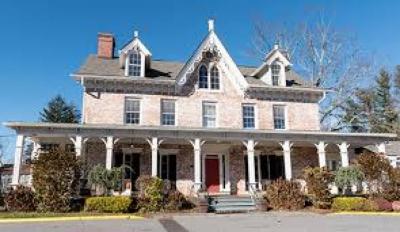Van Cortlandt Family Receipt Book
View Institution Homepage
Holding Library Call No.
V 2443Manuscript Cookbooks Survey Database ID#
1275Place of Origin
United States ➔ New York ➔ Cortlandt ManorDate of Composition
ca. 1770-1821Description
This receipt book is written in a journal sized volume that has been lovingly bound with a wallpaper cover. It is in a single hand through page 45, predominantly in one other hand from page 46 to the end. The first hand is likely that of Magdalena Douw Stevenson (1750-1817), the wife of John Stevenson (1734-1810), a wealthy Albany merchant. The second hand is that of their daughter, Ann Stevenson (1774-1821). In 1813 Ann became the second wife of Pierre Van Cortlandt II (1762-1848), who studied law with Alexander Hamilton, was elected to the New York State Assembly in 1792, 1794, and 1795 and to the U. S. Congress in 1811-12, and served in both the Revolutionary War and the War of 1812. The couple mostly resided at Van Cortlandt Upper Manor House, built by his Pierre’s father on the vast Van Cortlandt lands around 1773, in what is now the town of Cortlandt Manor, in Westchester County, New York. Van Cortlandt Upper Manor House is listed in the National Register of Historic Places and currently serves as a healthcare facility.
Magdalena may have begun the book around 1770, when she was a young woman. Since the initial section of the book contains recipes for dishes common in the seventeenth as well as the eighteenth century, it seems likely that some of Magdelena’s recipes in this section were handed down from her mother. The latter portion of the book moves forward in time. It includes recipes that call for pearl ash (potassium carbonate), America’s first “baking soda,” which came into use toward the end of the eighteenth century, as well as references to “tablespoons,” a unit of measure that emerged in the early nineteenth century.
The book reflects the cultural evolution of the Dutch-American Van Cortlandt family as the Hudson Valley, originally part of the Dutch colony of New Netherland, became increasingly English in orientation after it became the English colony of New York, in 1674. The manuscript is rooted in Dutch tradition, with recipes for traditional Dutch treats such as oley cookes (doughnuts), bolla bouches (puffy pancakes), and waffles, but most of its recipes cover English fare such as custards, Shrewsbury cake, mince pie, and boiled marrow pudding. Recipes make use of fish caught in the historically bountiful Hudson River and of game hunted in its surroundings, and they also make use of imported ingredients, such as sugar, citrus fruits, almonds, coconut, and spices (cinnamon, cloves, mace, nutmeg, and allspice), all of which were fairly common in the kitchens of very affluent families. The book glosses everyday fare like pancakes and various pickled and salt-preserved foods as well as fancy sweetmeats for special occasions.
Many of the receipts assume a certain level of expertise and provide only a list of ingredients or just few words of explanation regarding cooking procedures. Some receipts, however, go into minute detail about what the cook should expect as she proceeds and how to fix common mistakes. Possibly tricky procedures are elucidated with helpful hints or relevant information, including, in one recipe, notes on different drippings at “the Oyster Houses.” This reference not only tells us something about the families’ tastes but also provides fascinating information about the common culinary practices of commercial eating establishments in New York prior to 1800.
As was typical of home receipt books, the book contains some non-culinary material, including detailed home remedies, chemical mixtures for dog bites, instructions for making different colors of paint, miscellaneous advice, and a pattern for the weaving of a rug. Also typical, nineteenth-century newspaper clippings are glued onto the front and back pages of the book, giving it an element of a scrapbook. Judging from the care they took in preserving this book and passing it down to future generations, these recipes must have been of great value to the Van Cortlandt family. It is a critical resource in understanding the rich foodways of the historic Hudson Valley.
Pierre Van Cortlandt II was born at Van Cortlandt Manor House, in Croton-on-Hudson, New York. The house was originally built as a hunting lodge, in the late seventeenth century, by Pierre’s great-grandfather, Stephanus Van Cortlandt (1643-1700), on an 86,000 acre tract of land that Stephanus purchased from Native Americans. Pierre’s father, Pierre Van Cortlandt I, expanded and remodeled the manor and made it his family’s residence in 1749. The house remained in the Van Cortlandt family into the twentieth century. In 1953 it was purchased and restored by John D. Rockefeller and is now one of the five historic sites operated by Historic Hudson Valley, a historic preservation society headquartered in Pocantico Hills, New York.
This manuscript is held in the library and collections museum of Historic Hudson Valley, which is located in in Tarrytown, New York. The library is open by appointment.

